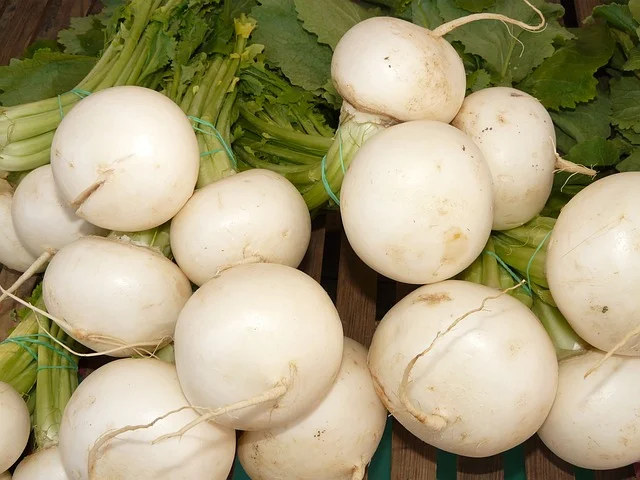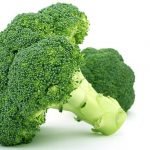
The white turnip is a vegetable rich in beneficial properties and an ally of our health.
Turnip is a vegetable belonging to the Brassicaceae family, together with cabbage, broccoli and savoy cabbage. The turnip as a vegetable with a rounded shape is actually the root of the plant, which exposes the leaves, which are also edible, above the ground. The white turnip can actually have various colors, ranging from white to yellowish or various shades of violet.
These are typically autumn and winter vegetables, although young turnips can be found as early as spring. They are generally harvested from October to March. Let’s now see the nutritional properties of the white turnip.
White turnip: calories and nutritional properties
The white turnip is a food very low in calories, it provides about 28 kcal per 100 grams, in fact it is made up of about 92% water, about 10% carbohydrates, fats are almost non-existent, few proteins and a fair amount amount of fiber.
The white turnip contains several mineral salts, in particular potassium, calcium and sodium and also vitamins, especially those of group B and vitamin C, an antioxidant vitamin, whose action is strengthened by other antioxidant compounds.
Furthermore, white beetroot contains sulforaphane, a compound with anti-inflammatory and antioxidant properties also present in cabbage. In addition to sulforaphane, this vegetable also contains quercetin and other flavonoids, compounds which, as we will see shortly, give the white turnip antioxidant and anti-inflammatory properties. For the sake of completeness, the following table shows the nutritional values of the white turnip.
Nutritional values per 100g of white turnip:
- Kcal: 28
- Carbohydrates: 10.23 g
- Fat: 0.1 g
- Proteins: 0.9 g
- Fibers: 1.8 g
- Waterfall: 91.87 g
- Iron: 0.3 mg
- Soccer: 30 mg
- Sodium: 67 mg
- Potassium: 191 mg
- Phosphorus: 27 mg
- Zinc: 0.27 mg
- Magnesium: 11 mg
- Vitamin B1: 0.04 mg
- Vitamin B2: 0.03 mg
- C vitamin: 21 mg
- Vitamin B3: 0.4 mg
- Vitamin B6: 0.09 mg
- Vitamin E: 0.03 mg
White turnip: the health benefits
The nutritional composition of the white turnip gives it a series of beneficial properties for our body. It is a vegetable, which, as we have seen, we can easily find for many months a year and is well suited to be consumed by everyone, even during pregnancy, due to the high content of vitamins and mineral salts, by those on a diet for the low calorie content, by the elderly for its remineralizing and moisturizing properties. In particular, the turnip has antidiabetic, antihypertensive, antioxidant and hepatoprotective properties. Now let’s see in more detail the benefits of the white turnip.
✓ Antioxidant properties
The white turnip has antioxidant properties due to its content in flavonoids and in particular in quercetin, whose action is associated with that of vitamin C, also with antioxidant properties and therefore protective against damage caused by free radicals to cells.
✓ Anti-inflammatory effects
The white turnip exerts its anti-inflammatory effects on various organs and systems. In fact, by virtue of the content of sulforaphane, a compound with antioxidant and anti-inflammatory properties, turnip protects the mucous membrane of the stomach and digestive tract in general, regulates blood pressure with beneficial effects on the cardiovascular system, protects the integument, fights infections bacterial.
✓ Detoxifying
The white turnip is considered a detoxifying food, first of all because it is diuretic thanks to its high water content and secondly because it contains sulfur, an important mineral that helps our body to get rid of waste.
✓ Supports the immune system
The white turnip is a support for the immune system since it contains antioxidant compounds that prevent cell damage caused by aging and at the same time exert an anti-inflammatory action as they contain mineral salts essential for many cellular functions, as well as B vitamins important for health of blood cells.
✓ Expectorant
By fluidifying the mucus and other secretions of our body, the white turnip exerts an expectorant action, very useful in case of colds and respiratory problems . In this regard, a popular remedy common in northern Europe involves cutting a turnip in half, emptying it of the pulp in the central part (with the help of a teaspoon) and then putting honey inside it, to be consumed in teaspoons to pass cough and sore throat.
✓ Supports the digestive processes
The fibers present in the turnip, associated with the action of water, are a panacea for the intestine, since they promote its motility, and also for the stomach since they assist the digestive processes.
✓ Help against diabetes
Eating white turnips can also help with blood sugar control and diabetes. This characteristic is always given by the presence of fibers, which are also able to modulate the absorption of sugars by the cells, thus regulating blood sugar.
✓ Promotes healthy skin and hair
Vitamin C, beta carotene and copper contained in turnip help keep skin and hair healthy by protecting them and promoting their regeneration.
✓ Aid for cardiovascular health
The white turnip, due to its potassium and sulforaphane content, helps regulate blood pressure and, therefore, is one of the foods to be consumed in case of hypertension. Furthermore, the sulforaphane present in the vegetable also has a beneficial effect on the entire cardiovascular system, therefore not only high blood pressure but also hypercholesterolemia and atherosclerosis.
White turnip: how to cook and some recipe tips
It is very easy to find white turnips in the fruit and vegetable markets from October and throughout the winter and it is possible to buy them without branches and leaves or together with the leaves, which can be eaten. Turnip greens are also well known, but they belong to another variety of turnip (Brassica rapa var. Sylvestris). But how do you eat a turnip? Let’s see below the methods of preparation and cooking.
Once you have purchased the white turnip, if we want to prepare only the roots, the first operation to do will be to deprive them of the small stems and wash them well to remove all soil residues. We then proceed by peeling the turnip with a potato peeler or a simple knife. We can then cut them into more or less thin slices or into chunks depending on the preparation we want to make.
The best way to eat white turnips is definitely raw, since cooking inactivates many of the antioxidant compounds they contain, such as isothiocyanates, so adding them raw to a mixed salad dressed with extra virgin olive oil would ‘ideal. If we don’t want to eat it raw, we can steam the white turnip for a few minutes.
The turnip, however, lends itself to many preparations, so perhaps the simplest way to cook it is in a pan with a drizzle of oil and a clove of garlic, in this case we could also avoid peeling it if we washed it thoroughly. If we want to obtain a more crunchy consistency, just cook the white turnip for a few minutes, if instead we want to have a softer consistency we will lengthen the cooking times and cover the pot with a lid. In this way the turnips can be an excellent side dish for roasted meat or fish-based main courses.
For a tastier side dish we can also opt for the method of cooking the turnip in the oven, even au gratin. In this case, the vegetables must be cut into cubes or slices and placed in the oven at 180 degrees for about twenty minutes. Then they can be seasoned with oil and with herbs and spices that we like best. If we slice them very thinly, always baked on a baking sheet lined with parchment paper, we could get some very tasty chips.
However, turnips are also suitable for vegetarian recipes of first courses, such as risottos or vegetable and cereal soups, both in pieces and in the form of velvets. In fact, we can find turnip in numerous recipes. To find out more, we invite you to read our in-depth analysis on the 10 uses of turnip in recipes.
White turnip and red turnip: nutritional differences
Despite having the same name and shape, the red turnip and the white turnip are both tubers, but belonging to two different families, respectively the Chenopodiaceae and the Brassicaceae. Beetroot or beetroot is scientifically called beta vulgaris and belongs to the same family as sugar beet, although it differs in genetic and nutritional characteristics. The white turnip, on the other hand, as we have just seen, is a “close relative” of cabbage, broccoli and savoy cabbage.
These two types of turnip, in fact, also have different nutritional characteristics. They both have a reduced calorie content and contain mostly water, but the red turnip contains more sugar than the white one and the content of some mineral salts is also different. In fact, while the red turnip contains on average more mineral salts than the white turnip, the calcium content is higher in the latter. Vitamin C is also more abundant in white turnips.
Even the preparations in the kitchen of the two types of turnip are different: while as we have seen the white turnip lends itself to very various preparations, usually the red turnip is consumed boiled or steamed. It can certainly be eaten raw, but after cutting it into very thin slices or grated.
Contraindications of the white turnip
The consumption of white turnip has no major contraindications, due to its content in thiocyanates, however, those with thyroid pathologies should not excessively consume it, since these compounds can interfere with the synthesis of thyroid hormones. Since cooking partially inactivates these substances, you could eat them cooked and in any case avoid a very frequent consumption, it is however advisable to talk to your doctor in case you have problems of this type.






